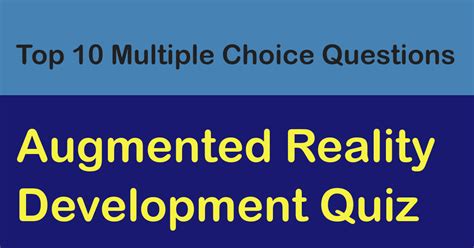Introduction

Augmented Reality (AR) has emerged as a transformative technology, seamlessly blending the digital and physical worlds. Embark on this comprehensive quiz to test your AR knowledge and uncover the hidden gems of this innovative realm.
Section 1: Defining AR
- What is the definition of Augmented Reality?
A. Enhancing the physical environment with digital content
B. Replacing the physical environment with virtual elements
C. Merging the digital and physical worlds
D. Creating virtual experiences only accessible through headsets
- Which industry pioneered the widespread adoption of AR?
A. Healthcare
B. Manufacturing
C. Gaming
D. Retail
Section 2: AR in Action
- Name the technology that allows AR devices to superimpose digital content onto the real world.
A. Holographic projection
B. Optical see-through display
C. Computer vision
D. Motion tracking
- What is the estimated size of the global AR market by 2026?
A. $100 billion
B. $200 billion
C. $300 billion
D. $400 billion
Section 3: AR Applications
- In which field is AR used to assist surgeons in visualizing complex procedures?
A. Healthcare
B. Education
C. Manufacturing
D. Marketing
- Name the AR technology that enables users to interact with virtual objects in the physical world.
A. Spatial computing
B. Holographic interactions
C. Haptic feedback
D. Gesture recognition
Section 4: AR Development
- What programming language is widely used for AR development?
A. Python
B. C++
C. Java
D. JavaScript
- Which software framework is commonly used for building immersive AR experiences?
A. Unity
B. Vuforia
C. Google ARCore
D. Apple ARKit
Section 5: AR Trends
- What is a key trend driving the growth of AR in the enterprise sector?
A. Increased demand for remote assistance
B. Integration with IoT devices
C. Focus on employee training
D. All of the above
- Which industry is expected to see the highest adoption of AR in the coming years?
A. Healthcare
B. Manufacturing
C. Construction
D. Education
Section 6: Common Mistakes to Avoid
To fully leverage the potential of AR, it’s crucial to avoid common pitfalls:
- Overloading the user with information: Keep AR experiences concise and focused.
- Ignoring the user’s context: Consider the user’s environment and surroundings when designing AR applications.
- Using outdated technology: Stay up-to-date with the latest AR advancements to ensure optimal performance.
- Ignoring the ethical implications: Respect user privacy and address ethical concerns in AR applications.
Section 7: How to Get Started with AR
Embark on your AR journey by following these steps:
- Identify a suitable industry and use case.
- Learn the basics of AR development.
- Build a prototype to test your concept.
- Iterate and improve based on feedback.
Why AR Matters
AR has the power to:
- Enhance user experiences
- Improve efficiency and productivity
- Foster innovation and creativity
- Revolutionize industries across the board
Benefits of AR
By embracing AR, businesses can reap numerous benefits:
- Increased customer engagement: Create immersive shopping experiences and enhance brand loyalty.
- Improved employee training: Provide realistic and interactive training simulations.
- Streamlined manufacturing processes: Optimize assembly lines and enhance quality control.
- Transform healthcare delivery: Assist surgeons, diagnose diseases, and improve patient outcomes.
Creative New Word: “ImaginARium”
To generate ideas for new AR applications, introduce the concept of “ImaginARium.” This term encapsulates the boundless possibilities of AR, empowering you to envision and create transformative experiences that transcend the boundaries of the physical world.
Table 1: Key AR Terms
| Term | Definition |
|---|---|
| Computer Vision | Detecting and analyzing real-world objects |
| Markerless Tracking | Tracking objects without the use of predefined markers |
| Depth Sensing | Estimating the distance between objects and the camera |
| Haptic Feedback | Providing tactile sensations to enhance user experience |
Table 2: AR Applications by Industry
| Industry | Use Case | Example |
|---|---|---|
| Healthcare | Surgical guidance | Visualizing complex procedures |
| Manufacturing | Quality assurance | Inspecting parts and detecting defects |
| Education | Interactive learning | Engaging students with virtual models |
| Retail | Product visualization | Allowing customers to interact with products virtually |
Table 3: AR Development Tools
| Tool | Features |
|---|---|
| Unity | Cross-platform development framework |
| Vuforia | Computer vision and image recognition |
| Google ARCore | Android-based AR development platform |
| Apple ARKit | iOS-based AR development platform |
Table 4: Common AR Mistakes
| Mistake | Impact |
|---|---|
| Overloading information | User confusion and fatigue |
| Ignoring context | Poor user experience |
| Using outdated technology | Limited capabilities and performance |
| Ignoring ethics | User privacy and societal concerns |
